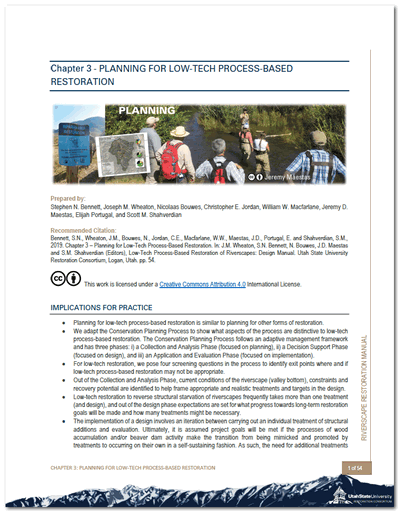Chapter 3: Planning for Low-Tech Process-Based Restoration
The third chapter covers planning for low-tech process-based restoration. It illustrates the process with the NRCS Conservation Planning Process and shows what aspects are distinctive to low-tech restoration. Specifically, it covers:
- Where to Plan?
- Phase 1: Collection & Analysis
- Phase 2: Decision Support & Design
- Phase 3: Application & Evaluation
- The Low-Tech Extension of the Conservation Planning Process
Chapter 3 also has appendices on:
- Appendix 3A: Parallels Between Different Planning Frameworks for Restoration
- Appendix 3B: Mapping Synthesis of Problems & Opportunities
- Appendix 3C: Mapping Valley Bottom for Assessing Space
- Appendix 3D: Assessing Risk to Property, Infrastructure, and Public Safety
- Appendix 3E: Assessing Riparian Conditions to Support Wood Accumulation
- Appendix 3F: Assessing Potential for Beaver Dam Activity
- Appendix 3G: Structure Level Adaptive Management
Full PDF available for free at ResearchGate, but requires a free account.
Implications for Practice

- Planning for low-tech process-based restoration is similar to other restoration planning.
- The Conservation Planning Process is adapted to highlight what is unique about low-tech restoration. It follows an adaptive management framework with three phases:
- Collection and Analysis
- Decision Support and Design
- Application and Evaluation
- For low-tech restoration, four screening questions are posed during the process to identify where low-tech process-based restoration may not be appropriate.
- From the Collection and Analysis Phase, valley bottom conditions, constraints, and recovery potential are identified to frame treatments and design targets.
- Low-tech restoration to reverse structural starvation of riverscapes often requires more than one treatment. Expectations for restoration progress are set during design, and the number of treatments required is discussed.
- Implementation involves iteratively carrying out structural additions and evaluation. Ultimately, the goal is that wood accumulation and beaver dam activity will transition from mimicked and promoted to self-sustaining. At that point, the project can be considered successful.
Recommended Citation
Bennett, S., Wheaton, J., Bouwes, N., Shahverdian, S., Macfarlane, W.W., and Portugal, E. 2019.
Chapter 3 – Planning for Low-Tech Process-Based Restoration.
In: Wheaton, J.M., Bennett, S., Shahverdian, S., Maestas, J.D. (Editors), Low-Tech Process-Based Restoration of Riverscapes: Design Manual – Version 1.0.
Utah State University Wheaton Ecogeomorphology & Topographic Analysis Lab, Logan, UT. 57 pp.
DOI: 10.13140/RG.2.2.15815.75680
Planning Distilled
These slides walk through a standardized Conservation Planning Process from NRCS (2007) and how it differs for low-tech process-based restoration.

